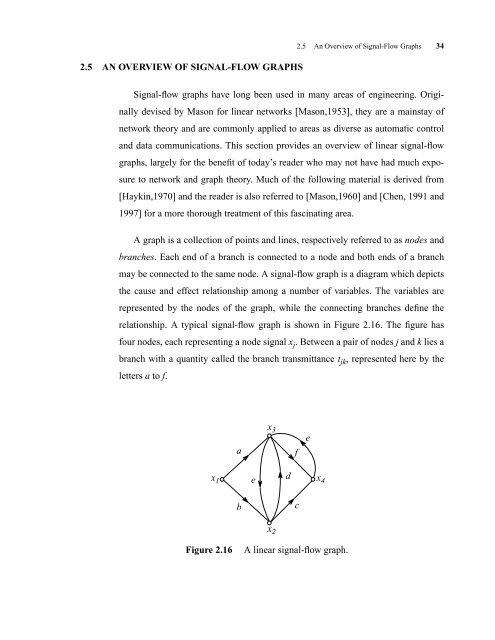CMOS Optical Preamplifier Design Using Graphical Circuit Analysis
CMOS Optical Preamplifier Design Using Graphical Circuit Analysis
CMOS Optical Preamplifier Design Using Graphical Circuit Analysis
Create successful ePaper yourself
Turn your PDF publications into a flip-book with our unique Google optimized e-Paper software.
2.5 AN OVERVIEW OF SIGNAL-FLOW GRAPHS<br />
2.5 An Overview of Signal-Flow Graphs 34<br />
Signal-flow graphs have long been used in many areas of engineering. Origi-<br />
nally devised by Mason for linear networks [Mason,1953], they are a mainstay of<br />
network theory and are commonly applied to areas as diverse as automatic control<br />
and data communications. This section provides an overview of linear signal-flow<br />
graphs, largely for the benefit of today’s reader who may not have had much expo-<br />
sure to network and graph theory. Much of the following material is derived from<br />
[Haykin,1970] and the reader is also referred to [Mason,1960] and [Chen, 1991 and<br />
1997] for a more thorough treatment of this fascinating area.<br />
A graph is a collection of points and lines, respectively referred to as nodes and<br />
branches. Each end of a branch is connected to a node and both ends of a branch<br />
may be connected to the same node. A signal-flow graph is a diagram which depicts<br />
the cause and effect relationship among a number of variables. The variables are<br />
represented by the nodes of the graph, while the connecting branches define the<br />
relationship. A typical signal-flow graph is shown in Figure 2.16. The figure has<br />
four nodes, each representing a node signal x j . Between a pair of nodes j and k lies a<br />
branch with a quantity called the branch transmittance t jk , represented here by the<br />
letters a to f.<br />
x 1<br />
a<br />
b<br />
e<br />
Figure 2.16 A linear signal-flow graph.<br />
x 3<br />
x 2<br />
d<br />
f<br />
c<br />
e<br />
x 4














